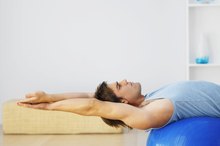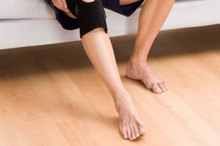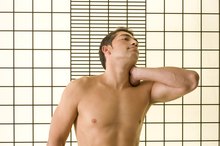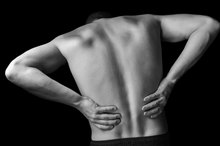What does fact checked mean?
At Healthfully, we strive to deliver objective content that is accurate and up-to-date. Our team periodically reviews articles in order to ensure content quality. The sources cited below consist of evidence from peer-reviewed journals, prominent medical organizations, academic associations, and government data.
The information contained on this site is for informational purposes only, and should not be used as a substitute for the advice of a professional health care provider. Please check with the appropriate physician regarding health questions and concerns. Although we strive to deliver accurate and up-to-date information, no guarantee to that effect is made.
Can Inversion Tables Help With Spinal Stenosis?
Spinal stenosis is a condition that can cause pain or numbness in your back, legs, neck, shoulders or arms 1. Other symptoms include weakness or loss of sensation in your arms and legs, balance issues, and bladder and bowel problems. These symptoms are painful and could cause a diminished quality of life. As you seek treatment for spinal stenosis, you may include inversion table therapy as one of your options 1. An inversion table is a piece of equipment that places you in an inverted position, lessening or eliminating the gravitational compression on your vertebrae.
If you are experiencing serious medical symptoms, seek emergency treatment immediately.
Definition and Causes
Spinal stenosis is the narrowing of your backbone, the body structure that normally protects your spinal cord 1. This narrowing can create pressure on your spinal cord. Oftentimes the cause of spinal stenosis is age-related, a result of osteoarthritis, degeneration of vertebral disks or thickening of the ligaments that hold together the bones of your spine 1. Other causes of this condition include injury, tumor growth or bone diseases of the spine.
Nonsurgical Treatments
Exercise Ball for Sciatica Relief
Learn More
Before you consider surgery as a treatment for your spinal stenosis, first explore nonsurgical treatments 1. You can relieve some symptoms with over-the-counter methods such as anti-inflammatory drugs or analgesics, corticosteroid injections to reduce inflammation in the spinal region, or nerve block injections to block pain. Your doctor may also prescribe strengthening and stabilizing exercises, or restrict certain activities that make your symptoms worse. You may need to wear a lumbar brace to support your spine.
- Before you consider surgery as a treatment for your spinal stenosis, first explore nonsurgical treatments 1.
- Your doctor may also prescribe strengthening and stabilizing exercises, or restrict certain activities that make your symptoms worse.
Alternative Treatments
You can use alternative therapies to treat spinal stenosis, either in place of or in conjunction with other treatments 1. According to the National Institute of Arthritis and Musculoskeletal and Skin Diseases, some patients report success using acupuncture therapy 2. Another alternative therapy is chiropractic care. Chiropractors adjust your spine to help restore normal spine movement and function, thereby reducing pain and symptoms associated with spinal stenosis 1. Research published in the "British Medical Journal" in 2006 concludes that chiropractic care is likely to be beneficial both in acute and chronic cases of back pain 3.
Inversion Table Therapy
How to Unpinch a Sciatic Nerve
Learn More
Gravity-assisted traction, or inversion, may help some spinal stenosis patients 1. This therapy employs a pulling force on the spine to increase space between the vertebrae and decrease pressure on the affected nerves. Overall, inversion table therapy has proven results in reducing back pain. A study by F. Sheffield in the "Archives of Physical Medicine and Rehabilitation" followed 175 patients who were unable to work due to various types of back pain 4. After eight inversion table treatments, 155 of these patients were able to return to their jobs full time. In treatment specifically for spinal stenosis, however, there is no significant evidence supporting the effectiveness of inversion table therapy 1. Although this therapy may temporarily reduce the symptoms caused by spinal stenosis, it will not reduce the narrowing of the spine indicative of the condition 1. Inversion table therapy may be suitable as a complement to the other treatments available for spinal stenosis 1.
Related Articles
References
- MayoClinic.com: Spinal Stenosis
- National Institute of Arthritis and Musculoskeletal and Skin Diseases: Spinal Stenosis
- "British Medical Journal"; Diagnosis and Treatment of Low Back Pain; B.W. Koes, et al.; June 2006
- “Archives of Physical Medicine and Rehabilitation”; Adaptation of Tilt Table for Lumbar Traction; F. Sheffield; Sept. 1964
- American Academy of Orthopaedic Surgeons: Lumbar Spinal Stenosis
- American Academy of Orthopaedic Surgeons. Lumbar Spinal Stenosis. Updated December 2013.
- Lee SY, Kim T-H, Oh JK, Lee SJ, Park MS. Lumbar Stenosis: A Recent Update by Review of Literature. Asian Spine J. 2015 Oct;9(5):818-28. doi:10.4184/asj.2015.9.5.818
- Akhavan-Sigari R, Rohde V, Alaid A. Cervical Spinal Canal Stenosis and Central Disc Herniation C3/4 in a Man with Primary Complaint of Thigh Pain. J Neurol Surg Rep. 2013 Dec;74(2):101-4. doi:10.1055/s-0033-1349202
- Takenaka S et al. Neurological Manifestations of Thoracic Myelopathy. Arch Orthop Trauma Surg. 2014 Jul;134(7):903-12. doi:10.1007/s00402-014-2000-1
- American College of Rheumatology. Spinal Stenosis. Updated March 2019.
- Issack PS, Cunningham ME, Pumberger M, Hughes AP, Cammisa FP. Degenerative lumbar spinal stenosis: evaluation and management. J Am Acad Orthop Surg. 2012;20(8):527-35. doi:10.5435/JAAOS-20-08-527
Writer Bio
Erica Manning has worked as a personal trainer and a weight management consultant since 2004. She is the author of her own health and fitness blog and also writes marketing materials for Manning Family Chiropractic in Ohio. Manning is certified through the American Council on Exercise and has a Bachelor of Science in marketing from the University of Colorado at Boulder.









